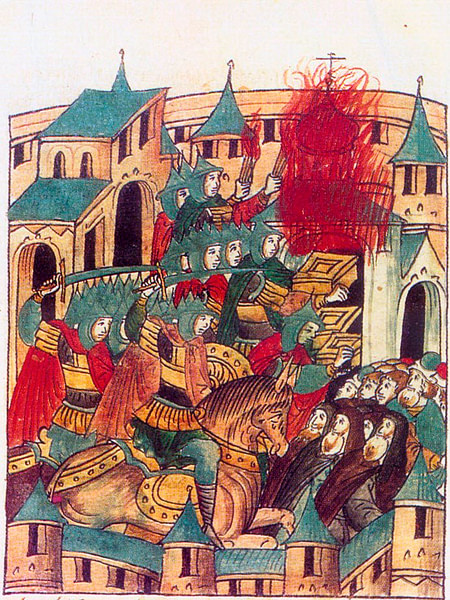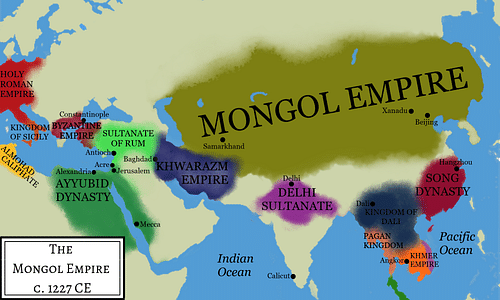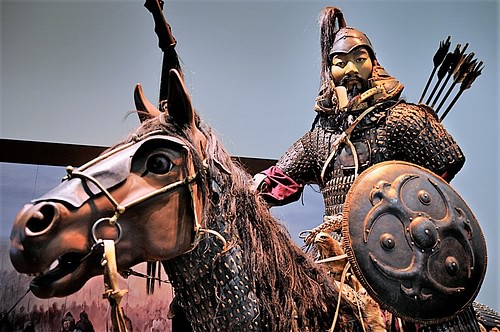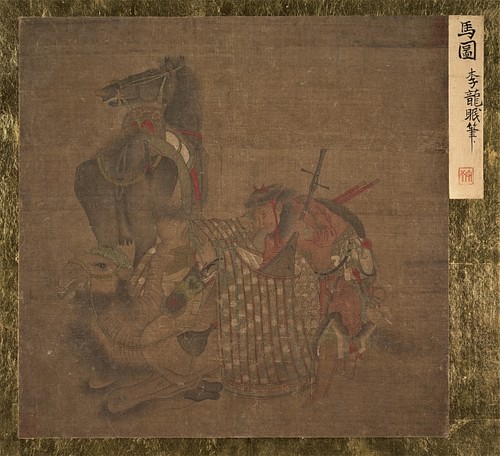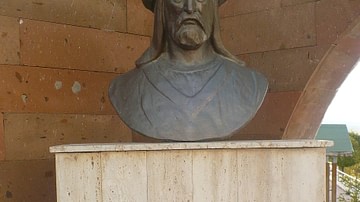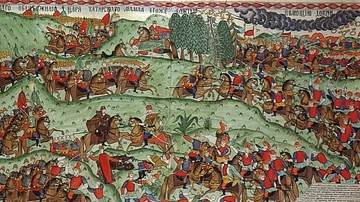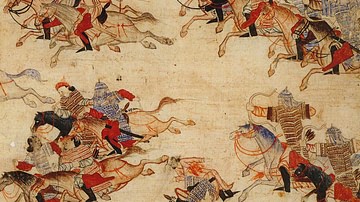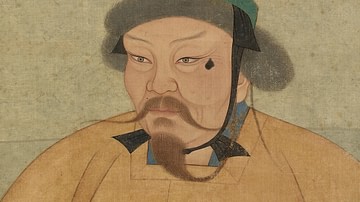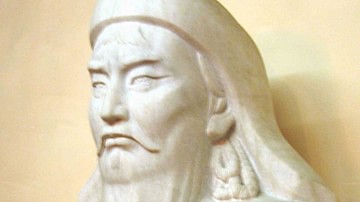The Mongol invasions of Russia and Eastern Europe occurred first with a brief sortie in 1223 CE and then again in a much larger campaign between 1237 CE and 1242 CE. The Mongols, seemingly coming from nowhere and quickly gaining a reputation as the 'horsemen of the Devil', enjoyed victory after victory, and eventually got as far west as the city of Wroclaw in Poland.
Great cities like Tbilisi, Kiev and Vladimir fell and, reaching the Danube river, they sacked the Hungarian cities of Buda, Pest, and Gran (Esztergom). Neither the Russians or the major European powers could organise themselves sufficiently to adequately meet the five-pronged attack the Mongols had launched or deal with their swift cavalry, incendiary-firing catapults and terror tactics. The rest of Eastern and Central Europe was only saved by the death of Ogedei Khan (r. 1229-1241 CE) which caused the Mongols to retreat. Despite the massive death and destruction there were some lasting cultural benefits to the invasion as the two worlds of east and west finally met. Western travellers began to visit East Asia, a region that had hitherto been a legendary land of monsters - a view the Chinese also held in regard to Europe. With the Mongol invasion of Europe, the world had become a lot more violent and just that bit smaller.
Ogedei Khan
Ogedei Khan became ruler of the Mongol Empire in 1229 CE, inheriting from his father Genghis Khan (r. 1206-1227 CE) an impressive swathe of Asia. The new khan was faced with two major problems at the outset of his reign: first, the imperial treasury was empty and riches were badly needed to keep the Mongol army loyal, and second, the Mongols had defeated many armies and deposed just as many rulers but they had very little in the way of a state apparatus, bureaucracy or government which would allow them to effectively rule these conquered territories. Ogedei realised that solving the second problem and being then able to impose taxes on conquered peoples would also solve the first problem. This is what transpired with ministers and officials being sent to govern various regions and supervise local tax collectors. With a new capital established at Karakorum (1235 CE), a more solid state apparatus in place and a steady income guaranteed, the khan could turn his attention to expanding his empire even further.
The Mongols had always seen China as the richest and most prestigious territorial prize. In 1230 CE China was divided into two large states: the Jurchen Jin state in the north and Song Dynasty China (960-1279 CE) in the south. After campaigns from 1230 to 1234 CE, the Jin state collapsed but the Song were to be left for a future date. Instead, Ogedei turned to the west.
Conquering the West
The Russian Principalities
The armies of Genghis Khan had swept across western Asia, circled around the Caspian Sea and even defeated a Russian army at Kalka 1223 CE but, now, many of the defeated states in the region were proving less than willing to pay the khan the tribute expected of them. Accordingly, Ogedei sent an army to persuade them. The Khwarazm Empire bore the brunt of Ogedei's fury throughout the 1230s CE. In 1235 CE northern Iraq was invaded. Victory followed victory, and the Mongol armies pushed into Azerbaijan, Georgia, and Armenia in 1238 CE, steadily wearing down the fortified towns of the region, sacking such cities as Tiflis (Tbilisi) and extracting tribute from local princes.
In a multi-pronged and intercontinental assault on Eurasia and Eastern Europe from 1236 CE, another army marched through Kazakhstan/Uzbekistan, defeating the Bashkirs and Bulgars along the way, to then attack the Russian principalities across the Volga River in the winter of 1237-8 CE. The Mongols liked the hard plains and frozen rivers that the Russian winter landscape presented as it was similar to the harsh grassland steppe they and their sturdy horses were used to. In 1237 CE the city of Ryazan (Riazan) was besieged between 16 and 21 December, its dreadful fate described thus in the Voskresensk Chronicle:
The Tartars took the town of Riazan…and burned it all, and killed its prince Yuri and his princess and seized the men, women and children, the monks, nuns and priests; some they struck down with swords, while others they shot with arrows and flung into the flames; still others they seized and bound, cut and disembowelled their bodies.
(quoted in Turnbull, 45)
The horror of Ryazan would be repeated again and again as the Mongols showed no mercy, and the Russian princes, beset by long-standing rivalries, could not work together even in this great emergency. Next came Moscow's turn to be torched, at the time not the great city it would later become, then Suzdal in 1238 CE, and finally Vladimir, the fortified capital, was besieged. Grand Duke Yuri II fled the city, leaving his wife and sons to face the attack. Having gathered his army together, Grand Duke Yuri then returned to try and relieve the city, but it had already fallen on 7 February to the Mongol battering rams and catapults, its cathedral torched. The duke's army was defeated and he himself was killed at the battle of Sit river. Disaster followed disaster, Torshok was another city that fell, this time after a prolonged resistance, on 23 March 1238 CE. In contrast, Novgorod was saved from attack as spring arrived and the Mongol army finally turned around and withdrew back to north of the Black Sea.
A third wave of Mongols moved into the Ukraine in 1239 CE, defeating the Polovtsians and then capturing Kiev after a brief siege on 6 December 1240 CE. The inhabitants of Kiev were put to the sword just as they had been elsewhere. Giovanni de Piano Carpini, an envoy of the Pope passed through the area six years later and made the following telling observation:
When we were journeying through that land we came across countless skulls and bones of dead men lying about on the ground. Kiev had been a very large and thickly populated town, but now it has been reduced to almost nothing.
(quoted in Turnbull, 49)
From Kiev the army moved through Galicia and Podolia and on to Eastern Europe, one wing moving northwest and attacking Poland, marching through Bohemia and Moravia and then attacking Hungary, while another headed south and attacked Transylvania, Moldavia, and Walachia. Hungary was selected as a primary target because of its grasslands, which the Mongols considered a perfect base for their horses from where they could then attack western Europe.
Poland
Polish towns were torched and the great city of Krakow (1241 CE) was easily captured after its abandonment by Boleslaw the Chaste (1226-1279 CE), the prince of that city, with the now-familiar routine of mass-slaughter and looting soon following. A trumpeter who had first sounded the alarm of the invaders' arrival was shot in the throat by a Mongol arrow and to this day the event is re-enacted (without the arrow) on the city's walls. Breslau (Wroclaw) was next but, there, the inhabitants so feared what was to come they themselves torched the city and took refuge in its castle citadel. The city was given a reprieve when, in 1241 CE, the Mongol commanders received news that a large Polish army was gathering under the command of Henry the Pious, the Duke of Silesia (r. 1238-1241 CE). At Wahlstatt near Liegnitz (Legnica), this army included Poles, Germans, and Teutonic knights amongst other heavy cavalry. The Mongol army rode to meet them on 9 April, promptly employed their tried-and-tested false retreat tactic, then attacked again under a smoke cover provided by burning the reeds thereabouts. The Mongols once again obliterated the opposition. Henry was killed and his head paraded on a spike, and the battle of Liegnitz became a highpoint in the invasion campaign; it was also the most westerly point reached. After the battle, the Mongol warriors were said to have filled nine sacks with their favourite trophy, the ears of their victims.
Hungary
At the same time as Poland was suffering, Hungary also found itself a Mongol target. A multi-pronged attack was launched in 1241 CE with an army moving through Moravia in the north and three more going through and around the Carpathian mountains in the west. The westernmost Mongol army went deep into Moldavia and Wallachia and then turned to attack Hungary from the south. A Hungarian army led by their king Bela IV (r. 1235-1270 CE) mobilised to meet the invaders in open country.
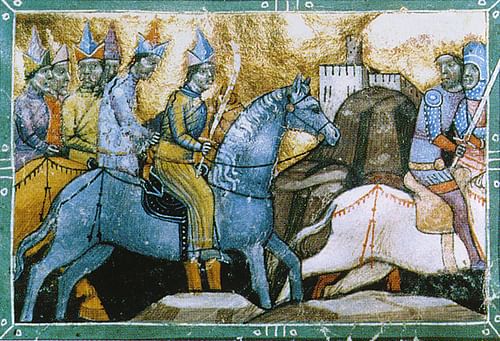
King Bela might have commanded one of the best armies in Europe but he had other problems besides the Mongols as many of his disgruntled barons had questionable loyalty to the crown. Another problem was rampaging Polovtsians who had fled the Mongol onslaught further east and were now raiding at will in Hungarian lands. In the event, Bela's army was roundly defeated on 10-11 April at the Battle of Mohi (modern Muhi) on the Sajo river after the Mongol commander Subutai (c. 1175-1248 CE) had his men cross a pontoon bridge and move through a swamp area to outflank the Hungarians. At the same time, Mongol catapults bombarded the enemy from the opposite bank of the river. Bela IV fled to the safety of Pressburg (Bratislava) and then Croatia. The Mongol armies, meanwhile, marched on relentlessly and they all met up on the Danube river in the first week of April. In 1241 CE, Buda and Pest were both sacked and looted, the latter on Christmas Day of all days, but the bigger prize was Gran (Esztergom), then the largest and richest city in the region. The Mongols employed 30 catapults in the subsequent siege which also began on Christmas Day 1241 CE, and the city fell shortly after. The invaders then followed the Danube westwards as far as Wiener Neustadt but here an army led by Duke Frederick II of Austria (r. 1230-1246 CE) caused the Mongols to at least pause for consideration.
Retreat
Meanwhile, yet another Mongol army pursued Bela into Croatia, sacking Zagreb along the way, then moving into Bosnia and Albania, and finally heading towards the Caspian Sea and Sarai which would become the capital of what became known as the Golden Horde. The northern Mongol forces also about-turned but this reprieve was likely not because of any enemy movements or threat but because of the momentous news that had finally filtered across Asia from Mongolia. Ogedei Khan had died on 11 December 1241 CE, and a successor now had to be chosen. The senior commanders would be needed to discuss and vote for the next khan in a traditional meeting of all the Mongol tribes.
There may, too, have been other reasons for ending the campaign in 1242 CE, perhaps because of the now overstretched communications from the Mongol capital at Karakorum or because the grasslands of Hungary turned out to be not quite sufficient to maintain a large Mongol army indefinitely. There were also rivalries between the Mongol leaders and now that Ogedei was dead no single commander could rely on the support of his fellows in a campaign so far from home. In any case, the prize the Mongols desired most was still to the east not west: Song Dynasty China (960-1279 CE), which was attacked and conquered during the reign of the next great Mongol ruler, Kublai Khan (r. 1260-1294 CE).
Why Were the Mongols so Successful?
The Mongol army had several advantages in their campaign against the Russians and Europeans. The first was that they were unknown. Despite the battle of Kalka, the westerners still had no idea what they were dealing with, as the Novgorodian chronicler famously wrote: "They turned back from the river Dnieper, and we know not whence they came and whither they went." A decade and a half later, no further intelligence had been gained.
They were expert archers using their far-shooting composite bows and extremely tough soldiers, capable of riding for days on end with minimal food and water. Their stocky but nimble horses were a weapon in themselves and capable of surviving harsh temperatures. The Mongols had both light and heavy cavalry, and each rider typically had up to 16 spare horses giving them a very long range of manoeuvre. The Mongol army could consequently move very fast over large areas of territory. In addition, they created strict schedules by which different divisions of an army would split up, engage the enemy in different places and then reunite at a specified location. It is for this reason that modern campaign maps for the Mongol invasion often resemble a plate of spaghetti as multiple armies moved in all directions.
On top of that, the Mongols never turned down an opportunity to employ enemy tactics and technology themselves. They not only brought ferocious mobility to warfare but they were, thanks to their flexibility, quickly adept at other types of battle, too, like siege warfare and the use of gunpowder missiles and catapults, all very far from traditional nomadic warfare. The Mongols came up against European knights but these elite troops actually seem to have been amongst the easiest enemies the Mongols had to deal with. The more agile Mongol cavalry simply did not stand its ground long enough for a group of knights to charge them with their own heavy horses.
Another advantage was that the Mongols knew how to exploit internal divisions in the enemy and stir up old rivalries that could weaken alliances, information often acquired by spies and merchants. Finally, motivation was high because Mongol warfare was designed for one purpose only: to gain booty.
Another successful weapon was psychological: terror. Genghis Khan had used the tactic to great effect, slaughtering men, women and children from captured cities and so forcefully persuading other cities to surrender lest the same fate befall them. The deliberate release of a few prisoners who had witnessed the mass-slaughter of innocents worked wonders on adjacent settlements. The Mongols under Ogedei continued the same tactics. Another utterly ruthless strategy was to use prisoners as human shields when Mongol troops advanced on a fortified city unwise enough to put up resistance, even to dress up prisoners as Mongol warriors and march them in the front ranks so that defenders wasted their precious arrows on killing their own compatriots.
Finally, the Mongols had one of the greatest military commanders of all time, Subutai Ba'adur (1176-1248 CE). Already vastly experienced from his campaigns under Genghis Khan against the Xia and Jin states in East Asia, the general was the supreme field commander of the forces which invaded western Asia and eastern Europe, even if the figurehead of the campaign was Batu (aka Bat-Qan, c. 1205-1255 CE), nephew of Ogedei Khan. Said to be too fat to ride a single pony, the commander travelled in a carriage but from there, Subutai commanded his troops with aplomb, his intervention at the battle of Mohi being particularly decisive.
Legacy: East Meets West
The Mongol armies may have done an about-turn in 1242 CE but the effects of their invasion far outlasted the relatively short military presence. First and foremost the death, destruction and forced displacement of peoples must rank high in any list of immediate consequences. While Europe continued as before in terms of power structures and rulers, the invasions in Russia and huge parts of western Asia overturned the status quo and these places remained under the 'Tartar yoke' for over a century. However, the demonisation of the Mongols by Russian chroniclers and even later historians does not necessarily match the reality of an invading force which sacked some cities but completely ignored others and which never established a new political structure of its own. Consequently, many Russian princes were able to rule with a high degree of autonomy after the invasion. Alexander Nevsky, prince of Vladimir (1221-1263 CE), is just one example and his successful campaigns against Swedish and German knights in 1240 CE illustrate that Russia was far from being obliterated by the Mongol invasion.
There was a second wave of consequences, slower and more subtle but, nevertheless not inconsequential. Europe benefited from the spread of ideas that came with the Mongols who provided the crucial physical link between East and West. Gunpowder, paper, printing, and the compass all became familiar in Europe. Westerners in the form of ambassadors, Papal emissaries, missionaries, and travellers like Marco Polo (1254-1324 CE) all saw for themselves the world of East Asia and brought back an equal mix of useful ideas and tall tales. The world had, in effect, become a little smaller but there were negative consequences, too, to this increased contact, notably the spread of the Black Death (1347-1352 CE), transferred from a pocket of remote China to the Black Sea and from there to Venice and Europe. The devastating plague would come again in successive waves throughout the 14th century CE and dwarf the casualties the Mongol hordes had caused a century before.
